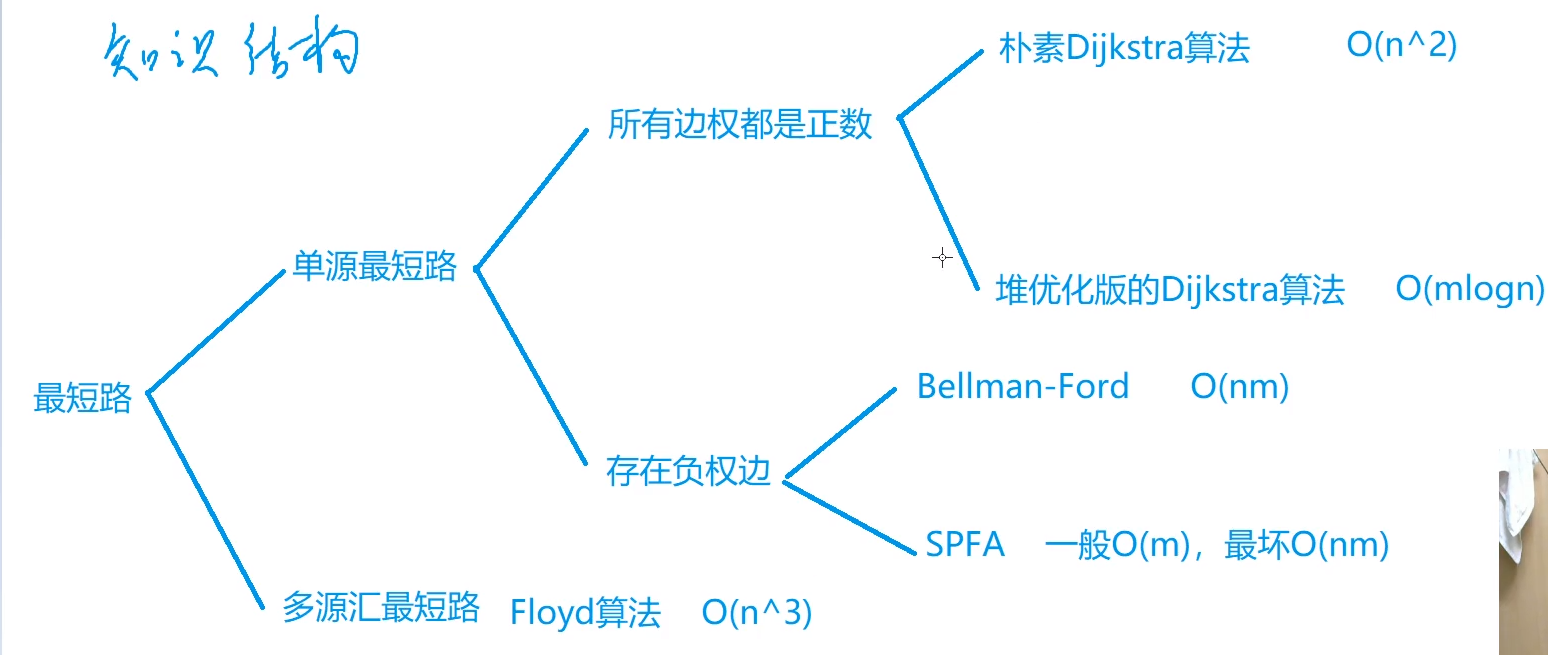
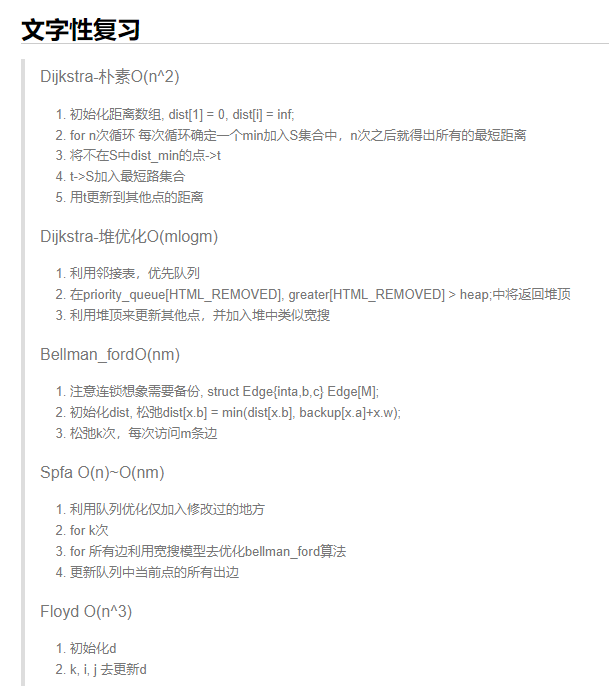
(1)Dijkstra求最短路 I(朴素)
给定一个 n 个点 m 条边的有向图,图中可能存在重边和自环,所有边权均为正值。
请你求出 1 号点到 n 号点的最短距离,如果无法从 1 号点走到 n 号点,则输出 −1。
输入格式
第一行包含整数 n 和 m。
接下来 m 行每行包含三个整数 x,y,z,表示存在一条从点 x 到点 y 的有向边,边长为 z。
输出格式
输出一个整数,表示 1 号点到 n 号点的最短距离。
如果路径不存在,则输出 −1。
数据范围
1≤n≤500,
1≤m≤105,
图中涉及边长均不超过10000。
输入样例:
3 3
1 2 2
2 3 1
1 3 4
输出样例:
3
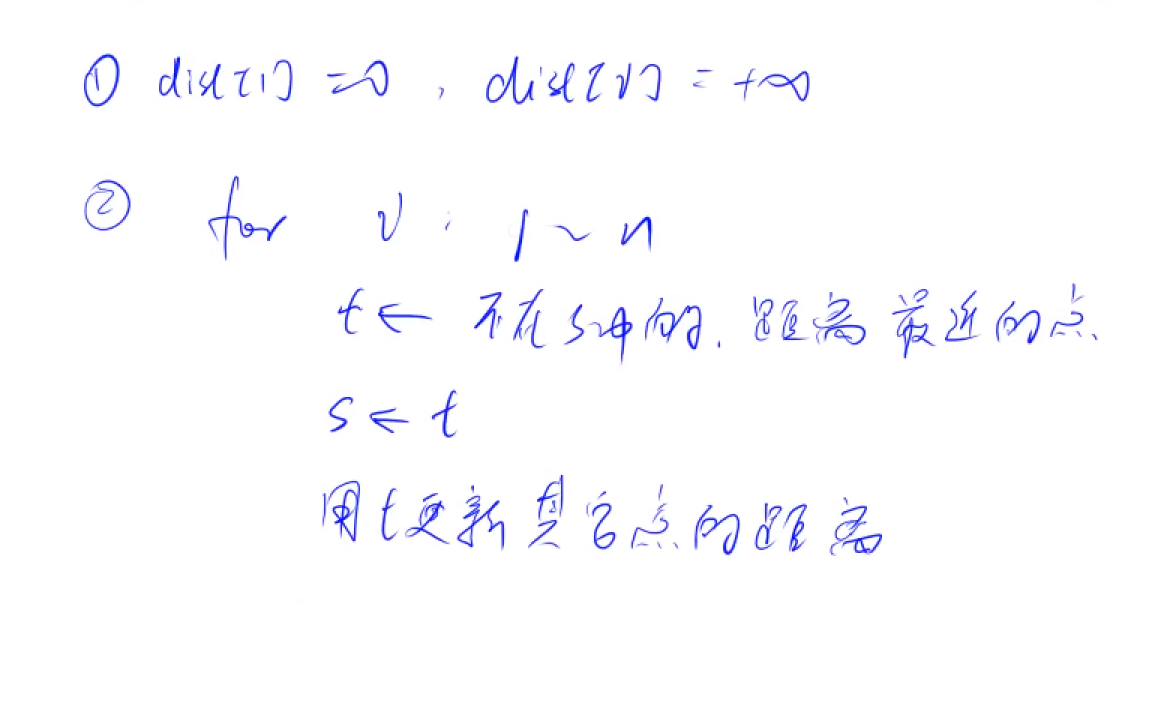
代码
#include<iostream>
#include<algorithm>
#include<cstring>
using namespace std;
const int N=510;
int g[N][N]; //为稠密阵所以用邻接矩阵存储
int dist[N]; //用于记录每一个点距离第一个点的距离
bool st[N]; //用于记录该点的最短距离是否已经确定
int n,m;
int Dijkstra()
{
memset(dist, 0x3f,sizeof dist); //初始化距离 0x3f代表无限大
dist[1]=0; //第一个点到自身的距离为0
for(int i=0;i<n;i++) //有n个点所以要进行n次 迭代
{
int t=-1; //t存储当前访问的点
for(int j=1;j<=n;j++) //这里的j代表的是从1号点开始
if(!st[j]&&(t==-1||dist[t]>dist[j]))
t=j;
for(int j=1;j<=n;j++) //依次更新每个点所到相邻的点路径值
dist[j]=min(dist[j],dist[t]+g[t][j]);
st[t]=true;
}
if(dist[n]==0x3f3f3f3f) return -1; //如果第n个点路径为无穷大即不存在最低路径
return dist[n];
}
int main()
{
cin>>n>>m;
memset(g,0x3f,sizeof g); //初始化图 因为是求最短路径
//所以每个点初始为无限大
while(m--)
{
int x,y,z;
cin>>x>>y>>z;
g[x][y]=min(g[x][y],z); //如果发生重边的情况则保留最短的一条边
}
cout<<Dijkstra()<<endl;
return 0;
}
总结:适合于稠密图(边多点少),用邻接矩阵来存图
最小花费
在 n 个人中,某些人的银行账号之间可以互相转账。
这些人之间转账的手续费各不相同。
给定这些人之间转账时需要从转账金额里扣除百分之几的手续费,请问 A 最少需要多少钱使得转账后 B 收到 100 元。
输入格式
第一行输入两个正整数 n,m,分别表示总人数和可以互相转账的人的对数。
以下 m 行每行输入三个正整数 x,y,z,表示标号为 x 的人和标号为 y 的人之间互相转账需要扣除 z% 的手续费 ( z<100 )。
最后一行输入两个正整数 A,B。
数据保证 A 与 B 之间可以直接或间接地转账。
输出格式
输出 A 使得 B 到账 100 元最少需要的总费用。
精确到小数点后 8 位。
数据范围
1≤n≤2000,
m≤105
输入样例:
3 3
1 2 1
2 3 2
1 3 3
1 3
输出样例:
103.07153164
难度:简单
时/空限制:1s / 64MB
总通过数:3838
总尝试数:8215
来源:《信息学奥赛一本通》
算法标签
代码
#include<iostream>
#include<algorithm>
#include<cstdio>
#include<cstring>
using namespace std;
const int N = 2010;
int n,m,S,T;
double dist[N];
double g[N][N];
bool st[N];
void dijkstra()
{
dist[S]=1;
for(int i=0;i<n;i++)
{
int t=-1;
for(int j=1;j<=n;j++)
{
if(!st[j]&&(t==-1||dist[t]<dist[j]))
{
t=j;
}
}
st[t]=true;
for(int j=1;j<=n;j++)
{
dist[j]=max(dist[j],dist[t]*g[t][j]);
}
}
}
int main()
{
cin>>n>>m;
while(m--)
{
int a,b,c;
cin>>a>>b>>c;
double z = (100.0 - c) / 100;
g[a][b]=g[b][a]=max(g[a][b],z);
}
cin >> S >> T;
dijkstra();
printf("%.8lf\n", 100 / dist[T]);
return 0;
}
昂贵的聘礼(利用虚拟源点)
年轻的探险家来到了一个印第安部落里。
在那里他和酋长的女儿相爱了,于是便向酋长去求亲。
酋长要他用 10000 个金币作为聘礼才答应把女儿嫁给他。
探险家拿不出这么多金币,便请求酋长降低要求。
酋长说:”嗯,如果你能够替我弄到大祭司的皮袄,我可以只要 8000 金币。如果你能够弄来他的水晶球,那么只要 5000 金币就行了。”
探险家就跑到大祭司那里,向他要求皮袄或水晶球,大祭司要他用金币来换,或者替他弄来其他的东西,他可以降低价格。
探险家于是又跑到其他地方,其他人也提出了类似的要求,或者直接用金币换,或者找到其他东西就可以降低价格。
不过探险家没必要用多样东西去换一样东西,因为不会得到更低的价格。
探险家现在很需要你的帮忙,让他用最少的金币娶到自己的心上人。
另外他要告诉你的是,在这个部落里,等级观念十分森严。
地位差距超过一定限制的两个人之间不会进行任何形式的直接接触,包括交易。
他是一个外来人,所以可以不受这些限制。
但是如果他和某个地位较低的人进行了交易,地位较高的的人不会再和他交易,他们认为这样等于是间接接触,反过来也一样。
因此你需要在考虑所有的情况以后给他提供一个最好的方案。
为了方便起见,我们把所有的物品从 1 开始进行编号,酋长的允诺也看作一个物品,并且编号总是 1。
每个物品都有对应的价格 P,主人的地位等级 L,以及一系列的替代品 Ti 和该替代品所对应的”优惠” Vi。
如果两人地位等级差距超过了 M,就不能”间接交易”。
你必须根据这些数据来计算出探险家最少需要多少金币才能娶到酋长的女儿。
输入格式
输入第一行是两个整数 M,N,依次表示地位等级差距限制和物品的总数。
接下来按照编号从小到大依次给出了 N 个物品的描述。
每个物品的描述开头是三个非负整数 P、L、X,依次表示该物品的价格、主人的地位等级和替代品总数。
接下来 X 行每行包括两个整数 T 和 V,分别表示替代品的编号和”优惠价格”。
输出格式
输出最少需要的金币数。
数据范围
1≤N≤100,
1≤P≤10000,
1≤L,M≤N,
0≤X<N
输入格式
1 4
10000 3 2
2 8000
3 5000
1000 2 1
4 200
3000 2 1
4 200
50 2 0
输出格式
5250
代码
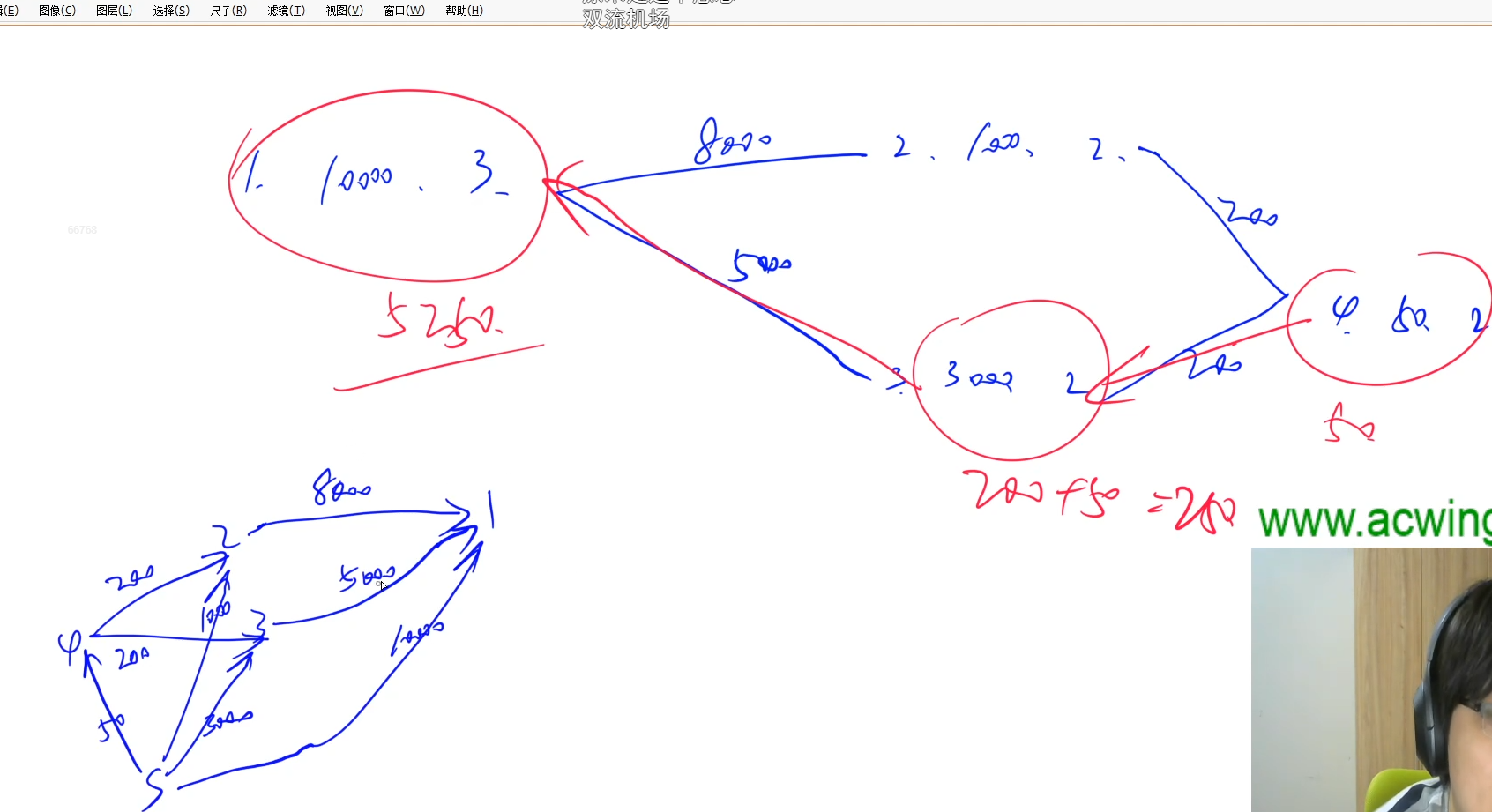
#include <cstring>
#include <iostream>
#include <algorithm>
using namespace std;
const int N = 110, INF = 0x3f3f3f3f;
int n, m;
int w[N][N], level[N];
int dist[N];
bool st[N];
int dijkstra(int down, int up)
{
memset(dist, 0x3f, sizeof dist);
memset(st, 0, sizeof st);
dist[0] = 0;
for (int i = 1; i <= n ; i ++ )
{
int t = -1;
for (int j = 0; j <= n; j ++ )
if (!st[j] && (t == -1 || dist[t] > dist[j]))
t = j;
st[t] = true;
for (int j = 1; j <= n; j ++ )
if (level[j] >= down && level[j] <= up)
dist[j] = min(dist[j], dist[t] + w[t][j]);
}
return dist[1];
}
int main()
{
cin >> m >> n;
memset(w, 0x3f, sizeof w);
for (int i = 1; i <= n; i ++ ) w[i][i] = 0;
for (int i = 1; i <= n; i ++ )
{
int price, cnt;
cin >> price >> level[i] >> cnt;
w[0][i] = min(price, w[0][i]);
while (cnt -- )
{
int id, cost;
cin >> id >> cost;
w[id][i] = min(w[id][i], cost);
}
}
int res = INF;
for (int i = level[1] - m; i <= level[1]; i ++ ) res = min(res, dijkstra(i, i + m));
cout << res << endl;
return 0;
}
(2)Dijkstra求最短路 II(堆优化版)
给定一个 n 个点 m 条边的有向图,图中可能存在重边和自环,所有边权均为非负值。
请你求出 1 号点到 n 号点的最短距离,如果无法从 1 号点走到 n 号点,则输出 −1。
输入格式
第一行包含整数 n 和 m。
接下来 m 行每行包含三个整数 x,y,z,表示存在一条从点 x 到点 y 的有向边,边长为 z。
输出格式
输出一个整数,表示 1 号点到 n 号点的最短距离。
如果路径不存在,则输出 −1。
数据范围
1≤n,m≤1.5×105,
图中涉及边长均不小于 0,且不超过 10000。
数据保证:如果最短路存在,则最短路的长度不超过 109。
输入样例:
3 3
1 2 2
2 3 1
1 3 4
输出样例:
3
代码
#include <cstring>
#include <iostream>
#include <algorithm>
#include <queue>
using namespace std;
typedef pair<int, int> PII;
const int N = 1e6 + 10;
int n, m;
int h[N], w[N], e[N], ne[N], idx;
int dist[N];
bool st[N];
void add(int a, int b, int c)
{
e[idx] = b, w[idx] = c, ne[idx] = h[a], h[a] = idx ++ ;
}
int dijkstra()
{
memset(dist, 0x3f, sizeof dist);
dist[1] = 0;
priority_queue<PII, vector<PII>, greater<PII>> heap;
heap.push({0, 1});//第一个参数:距离,第二个参数,点编号
while (heap.size())
{
auto t = heap.top();
heap.pop();
int ver = t.second, distance = t.first;
if (st[ver]) continue; //优先队列有冗余,已经确认的点就不用管了
st[ver] = true;
for (int i = h[ver]; i != -1; i = ne[i])
{
int j = e[i];
if (dist[j] > dist[ver] + w[i])
{
dist[j] = dist[ver] + w[i];
heap.push({dist[j], j});
}
}
}
if (dist[n] == 0x3f3f3f3f) return -1;
return dist[n];
}
int main()
{
scanf("%d%d", &n, &m);
memset(h, -1, sizeof h);
while (m -- )
{
int a, b, c;
scanf("%d%d%d", &a, &b, &c);
add(a, b, c);
}
cout << dijkstra() << endl;
return 0;
}
总结:稀疏图,用邻接表,n个点,在堆中修改一个数的时间复杂度是logn,所以是mlogn,st数组表示当前元素有没有出队
香甜的黄油
农夫John发现了做出全威斯康辛州最甜的黄油的方法:糖。
把糖放在一片牧场上,他知道 N 只奶牛会过来舔它,这样就能做出能卖好价钱的超甜黄油。
当然,他将付出额外的费用在奶牛上。
农夫John很狡猾,就像以前的巴甫洛夫,他知道他可以训练这些奶牛,让它们在听到铃声时去一个特定的牧场。
他打算将糖放在那里然后下午发出铃声,以至他可以在晚上挤奶。
农夫John知道每只奶牛都在各自喜欢的牧场(一个牧场不一定只有一头牛)。
给出各头牛在的牧场和牧场间的路线,找出使所有牛到达的路程和最短的牧场(他将把糖放在那)。
数据保证至少存在一个牧场和所有牛所在的牧场连通。
输入格式
第一行: 三个数:奶牛数 N,牧场数 P,牧场间道路数 C。
第二行到第 N+1 行: 1 到 N 头奶牛所在的牧场号。
第 N+2 行到第 N+C+1 行:每行有三个数:相连的牧场A、B,两牧场间距 D,当然,连接是双向的。
输出格式
共一行,输出奶牛必须行走的最小的距离和。
数据范围
1≤N≤500,
2≤P≤800,
1≤C≤1450,
1≤D≤255
输入样例:
3 4 5
2
3
4
1 2 1
1 3 5
2 3 7
2 4 3
3 4 5
输出样例:
8
代码
#include <queue>
#include <cstring>
#include <iostream>
#include <algorithm>
using namespace std;
typedef pair<int, int> PII;
const int N = 1010, M = 3010, INF = 0x3f3f3f3f;
int h[N], e[M], ne[M], w[M], idx;
int dist[N], cow[N], n, m, p;
bool st[N];
void add(int a, int b, int c)
{
e[idx] = b, w[idx] = c, ne[idx] = h[a], h[a] = idx ++;
}
int dijkstra_heap(int s)
{
memset(st, 0, sizeof st);
memset(dist, 0x3f, sizeof dist);
dist[s] = 0;
priority_queue<PII, vector<PII>, greater<PII>> heap;
heap.push({0, s});
while(heap.size())
{
PII t = heap.top();
heap.pop();
int ver = t.second, distance = t.first;
if(st[ver]) continue;
st[ver] = true;
for(int i = h[ver]; i != -1; i = ne[i])
{
int j = e[i];
if(dist[j] > distance + w[i])
{
dist[j] = distance + w[i];
heap.push({dist[j], j});
}
}
}
int ans = 0;
for(int i = 1; i <= n; i ++)
{
int j = cow[i];
if(dist[j] == INF) return INF;
ans += dist[j];
}
return ans;
}
int main()
{
memset(h, -1, sizeof h);
ios::sync_with_stdio(false), cin.tie(0), cout.tie(0);
cin >> n >> p >> m;
for(int i = 1; i <= n; i ++) cin >> cow[i];
while(m --)
{
int a, b, c;
cin >> a >> b >> c;
add(a, b, c), add(b, a, c);
}
int ans = INF;
for(int i = 1; i <= p; i ++) ans = min(ans, dijkstra_heap(i));
cout << ans;
return 0;
}
新年好
重庆城里有 n 个车站,m 条 双向 公路连接其中的某些车站。
每两个车站最多用一条公路连接,从任何一个车站出发都可以经过一条或者多条公路到达其他车站,但不同的路径需要花费的时间可能不同。
在一条路径上花费的时间等于路径上所有公路需要的时间之和。
佳佳的家在车站 1,他有五个亲戚,分别住在车站 a,b,c,d,e。
过年了,他需要从自己的家出发,拜访每个亲戚(顺序任意),给他们送去节日的祝福。
怎样走,才需要最少的时间?
输入格式
第一行:包含两个整数 n,m,分别表示车站数目和公路数目。
第二行:包含五个整数 a,b,c,d,e,分别表示五个亲戚所在车站编号。
以下 m 行,每行三个整数 x,y,t,表示公路连接的两个车站编号和时间。
输出格式
输出仅一行,包含一个整数 T,表示最少的总时间。
数据范围
1≤n≤50000,
1≤m≤105,
1<a,b,c,d,e≤n,
1≤x,y≤n,
1≤t≤100
输入样例:
6 6
2 3 4 5 6
1 2 8
2 3 3
3 4 4
4 5 5
5 6 2
1 6 7
输出样例:
21
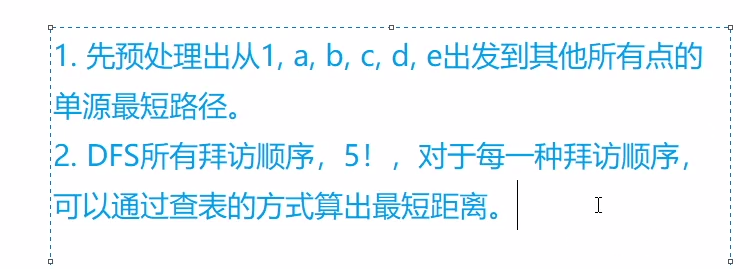
代码
#include <cstdio>
#include <cstring>
#include <iostream>
#include <algorithm>
#include <queue>
using namespace std;
typedef pair<int, int> PII;
const int N = 50010, M = 200010, INF = 0x3f3f3f3f;
int n, m;
int h[N], e[M], w[M], ne[M], idx;
int q[N], dist[6][N];
int source[6];
bool st[N];
void add(int a, int b, int c)
{
e[idx] = b, w[idx] = c, ne[idx] = h[a], h[a] = idx ++ ;
}
void dijkstra(int start, int dist[])
{
memset(dist, 0x3f, N * 4);
dist[start] = 0;
memset(st, 0, sizeof st);
priority_queue<PII, vector<PII>, greater<PII>> heap;
heap.push({0, start});
while (heap.size())
{
auto t = heap.top();
heap.pop();
int ver = t.second;
if (st[ver]) continue;
st[ver] = true;
for (int i = h[ver]; ~i; i = ne[i])
{
int j = e[i];
if (dist[j] > dist[ver] + w[i])
{
dist[j] = dist[ver] + w[i];
heap.push({dist[j], j});
}
}
}
}
int dfs(int u, int start, int distance)
{
if (u == 6) return distance;
int res = INF;
for (int i = 1; i <= 5; i ++ )
if (!st[i])
{
int next = source[i];
st[i] = true;
res = min(res, dfs(u + 1, i, distance + dist[start][next]));
st[i] = false;
}
return res;
}
int main()
{
scanf("%d%d", &n, &m);
source[0] = 1;
for (int i = 1; i <= 5; i ++ ) scanf("%d", &source[i]);
memset(h, -1, sizeof h);
while (m -- )
{
int a, b, c;
scanf("%d%d%d", &a, &b, &c);
add(a, b, c), add(b, a, c);
}
for (int i = 0; i < 6; i ++ ) dijkstra(source[i], dist[i]);
memset(st, 0, sizeof st);
printf("%d\n", dfs(1, 0, 0));
return 0;
}
(3)bellman-ford 有边数限制的最短路
给定一个 n 个点 m 条边的有向图,图中可能存在重边和自环, 边权可能为负数。
请你求出从 1 号点到 n 号点的最多经过 k 条边的最短距离,如果无法从 1 号点走到 n 号点,输出 impossible。
注意:图中可能 存在负权回路 。
输入格式
第一行包含三个整数 n,m,k。
接下来 m 行,每行包含三个整数 x,y,z,表示存在一条从点 x 到点 y 的有向边,边长为 z。
输出格式
输出一个整数,表示从 1 号点到 n 号点的最多经过 k 条边的最短距离。
如果不存在满足条件的路径,则输出 impossible。
数据范围
1≤n,k≤500,
1≤m≤10000,
任意边长的绝对值不超过 10000。
输入样例:
3 3 1
1 2 1
2 3 1
1 3 3
输出样例:
3
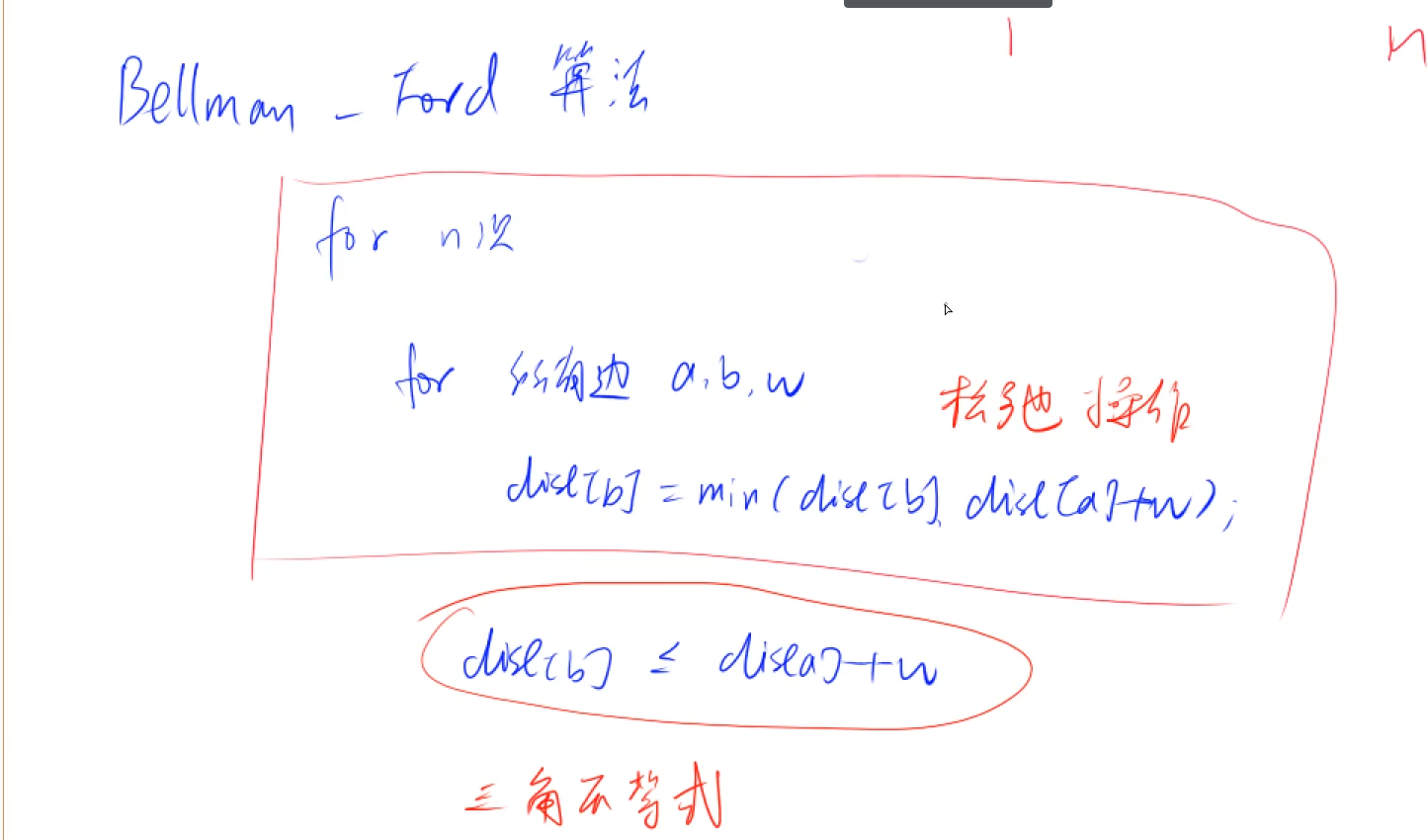
代码
#include <cstring>
#include <iostream>
#include <algorithm>
using namespace std;
const int N = 510, M = 10010;
struct Edge
{
int a, b, c;
}edges[M];
int n, m, k;
int dist[N];
int last[N];
void bellman_ford()
{
memset(dist, 0x3f, sizeof dist);
dist[1] = 0;
for (int i = 0; i < k; i ++ )
{
memcpy(last, dist, sizeof dist);
for (int j = 0; j < m; j ++ )
{
auto e = edges[j];
dist[e.b] = min(dist[e.b], last[e.a] + e.c);
}
}
}
int main()
{
scanf("%d%d%d", &n, &m, &k);
for (int i = 0; i < m; i ++ )
{
int a, b, c;
scanf("%d%d%d", &a, &b, &c);
edges[i] = {a, b, c};
}
bellman_ford();
if (dist[n] > 0x3f3f3f3f / 2) puts("impossible"); //存在负权回路
else printf("%d\n", dist[n]);
return 0;
}
(4)spfa求最短路
给定一个 n 个点 m 条边的有向图,图中可能存在重边和自环, 边权可能为负数。
请你求出 1 号点到 n 号点的最短距离,如果无法从 1 号点走到 n 号点,则输出 impossible。
数据保证不存在负权回路。
输入格式
第一行包含整数 n 和 m。
接下来 m 行每行包含三个整数 x,y,z,表示存在一条从点 x 到点 y 的有向边,边长为 z。
输出格式
输出一个整数,表示 1 号点到 n 号点的最短距离。
如果路径不存在,则输出 impossible。
数据范围
1≤n,m≤105,
图中涉及边长绝对值均不超过 10000。
输入样例:
3 3
1 2 5
2 3 -3
1 3 4
输出样例:
2
代码
#include <cstring>
#include <iostream>
#include <algorithm>
#include <queue>
using namespace std;
const int N = 100010;
int n, m;
int h[N], w[N], e[N], ne[N], idx;
int dist[N];
bool st[N];
void add(int a, int b, int c)
{
e[idx] = b, w[idx] = c, ne[idx] = h[a], h[a] = idx ++ ;
}
int spfa()
{
memset(dist, 0x3f, sizeof dist);
dist[1] = 0;
queue<int> q;
q.push(1);
st[1] = true;
while (q.size())
{
int t = q.front();
q.pop();
st[t] = false;
for (int i = h[t]; i != -1; i = ne[i])
{
int j = e[i];
if (dist[j] > dist[t] + w[i])
{
dist[j] = dist[t] + w[i];
if (!st[j]) //相比于bellman-ford方法,这里更新后的边才加入队列,不需要重新循环更新边
{
q.push(j);
st[j] = true;
}
}
}
}
return dist[n];
}
int main()
{
scanf("%d%d", &n, &m);
memset(h, -1, sizeof h);
while (m -- )
{
int a, b, c;
scanf("%d%d%d", &a, &b, &c);
add(a, b, c);
}
int t = spfa();
if (t == 0x3f3f3f3f) puts("impossible");
else printf("%d\n", t);
return 0;
}
总结:这个不需要dist[n] > 0x3f3f3f3f / 2的条件吗?
答:这个不需要,因为队列里都是由起点更新到的点,不存在bellman-ford算法中未更新的点同样被边更新的情况。
热浪
德克萨斯纯朴的民众们这个夏天正在遭受巨大的热浪!!!
他们的德克萨斯长角牛吃起来不错,可是它们并不是很擅长生产富含奶油的乳制品。
农夫John此时身先士卒地承担起向德克萨斯运送大量的营养冰凉的牛奶的重任,以减轻德克萨斯人忍受酷暑的痛苦。
John已经研究过可以把牛奶从威斯康星运送到德克萨斯州的路线。
这些路线包括起始点和终点一共有 T 个城镇,为了方便标号为 1 到 T。
除了起点和终点外的每个城镇都由 双向道路 连向至少两个其它的城镇。
每条道路有一个通过费用(包括油费,过路费等等)。
给定一个地图,包含 C 条直接连接 2 个城镇的道路。
每条道路由道路的起点 Rs,终点 Re 和花费 Ci 组成。
求从起始的城镇 Ts 到终点的城镇 Te 最小的总费用。
输入格式
第一行: 4 个由空格隔开的整数: T,C,Ts,Te;
第 2 到第 C+1 行: 第 i+1 行描述第 i 条道路,包含 3 个由空格隔开的整数: Rs,Re,Ci。
输出格式
一个单独的整数表示从 Ts 到 Te 的最小总费用。
数据保证至少存在一条道路。
数据范围
1≤T≤2500,
1≤C≤6200,
1≤Ts,Te,Rs,Re≤T,
1≤Ci≤1000
输入样例:
7 11 5 4
2 4 2
1 4 3
7 2 2
3 4 3
5 7 5
7 3 3
6 1 1
6 3 4
2 4 3
5 6 3
7 2 1
输出样例:
7
难度:简单
时/空限制:1s / 64MB
总通过数:5872
总尝试数:9921
来源:《信息学奥赛一本通》 , USACO
算法标签
代码
#include <cstring>
#include <iostream>
#include <algorithm>
#include <queue>
using namespace std;
const int N = 100010;
int n, m;
int h[N], w[N], e[N], ne[N], idx;
int dist[N];
bool st[N];
int S;
int T;
void add(int a, int b, int c)
{
e[idx] = b, w[idx] = c, ne[idx] = h[a], h[a] = idx ++ ;
}
int spfa()
{
memset(dist, 0x3f, sizeof dist);
dist[S] = 0;
queue<int> q;
q.push(S);
st[S] = true;
while (q.size())
{
int t = q.front();
q.pop();
st[t] = false;
for (int i = h[t]; i != -1; i = ne[i])
{
int j = e[i];
if (dist[j] > dist[t] + w[i])
{
dist[j] = dist[t] + w[i];
if (!st[j]) //相比于bellman-ford方法,这里更新后的边才加入队列,不需要重新循环更新边
{
q.push(j);
st[j] = true;
}
}
}
}
return dist[T];
}
int main()
{
scanf("%d%d%d%d", &n, &m,&S,&T);
memset(h, -1, sizeof h);
while (m -- )
{
int a, b, c;
scanf("%d%d%d", &a, &b, &c);
add(a, b, c);
add(b, a, c);
}
int t = spfa();
printf("%d\n", t);
return 0;
}
总结:spfa的st数组表示当前元素是否在队列当中
(5)spfa判断负环
给定一个 n 个点 m 条边的有向图,图中可能存在重边和自环, 边权可能为负数。
请你判断图中是否存在负权回路。
输入格式
第一行包含整数 n 和 m。
接下来 m 行每行包含三个整数 x,y,z,表示存在一条从点 x 到点 y 的有向边,边长为 z。
输出格式
如果图中存在负权回路,则输出 Yes,否则输出 No。
数据范围
1≤n≤2000,
1≤m≤10000,
图中涉及边长绝对值均不超过 10000。
输入样例:
3 3
1 2 -1
2 3 4
3 1 -4
输出样例:
Yes
难度:简单
时/空限制:1s / 64MB
总通过数:19280
总尝试数:38665
来源:模板题
算法标签
代码
#include <cstring>
#include <iostream>
#include <algorithm>
#include <queue>
using namespace std;
const int N = 2010, M = 10010;
int n, m;
int h[N], w[M], e[M], ne[M], idx;
int dist[N], cnt[N];
bool st[N];
void add(int a, int b, int c)
{
e[idx] = b, w[idx] = c, ne[idx] = h[a], h[a] = idx ++ ;
}
bool spfa()
{
queue<int> q;
for (int i = 1; i <= n; i ++ )
{
st[i] = true;
q.push(i); //每个点都可能是起点,都加入队列中
}
while (q.size())
{
int t = q.front();
q.pop();
st[t] = false;
for (int i = h[t]; i != -1; i = ne[i])
{
int j = e[i];
if (dist[j] > dist[t] + w[i])
{
dist[j] = dist[t] + w[i];
cnt[j] = cnt[t] + 1; //此时有多少边更新过
if (cnt[j] >= n) return true; //如果更新过的边数大于等于n个点,根据抽屉原理必经过负环即可判断
if (!st[j])
{
q.push(j);
st[j] = true;
}
}
}
}
return false;
}
int main()
{
scanf("%d%d", &n, &m);
memset(h, -1, sizeof h);
while (m -- )
{
int a, b, c;
scanf("%d%d%d", &a, &b, &c);
add(a, b, c);
}
if (spfa()) puts("Yes");
else puts("No");
return 0;
}
(6)选择最佳线路(spfa写法)
有一天,琪琪想乘坐公交车去拜访她的一位朋友。
由于琪琪非常容易晕车,所以她想尽快到达朋友家。
现在给定你一张城市交通路线图,上面包含城市的公交站台以及公交线路的具体分布。
已知城市中共包含 n 个车站(编号1~n)以及 m 条公交线路。
每条公交线路都是 单向的,从一个车站出发直接到达另一个车站,两个车站之间可能存在多条公交线路。
琪琪的朋友住在 s 号车站附近。
琪琪可以在任何车站选择换乘其它公共汽车。
请找出琪琪到达她的朋友家(附近的公交车站)需要花费的最少时间。
输入格式
输入包含多组测试数据。
每组测试数据第一行包含三个整数 n,m,s,分别表示车站数量,公交线路数量以及朋友家附近车站的编号。
接下来 m 行,每行包含三个整数 p,q,t,表示存在一条线路从车站 p 到达车站 q,用时为 t。
接下来一行,包含一个整数 w,表示琪琪家附近共有 w 个车站,她可以在这 w 个车站中选择一个车站作为始发站。
再一行,包含 w 个整数,表示琪琪家附近的 w 个车站的编号。
输出格式
每个测试数据输出一个整数作为结果,表示所需花费的最少时间。
如果无法达到朋友家的车站,则输出 -1。
每个结果占一行。
数据范围
n≤1000,m≤20000,
1≤s≤n,
0<w<n,
0<t≤1000
输入样例:
5 8 5
1 2 2
1 5 3
1 3 4
2 4 7
2 5 6
2 3 5
3 5 1
4 5 1
2
2 3
4 3 4
1 2 3
1 3 4
2 3 2
1
1
输出样例:
1
-1
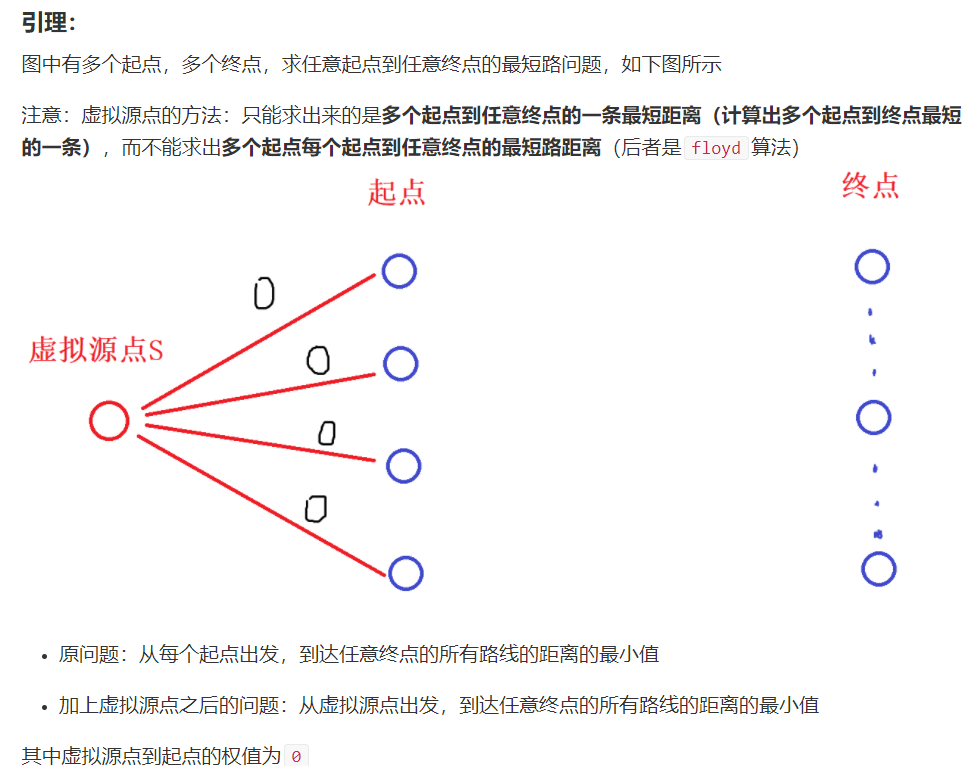
代码
#include <iostream>
#include <cstdio>
#include <cstring>
#include <algorithm>
#include <queue>
using namespace std;
//本题考查图论的一个小技巧,超级源点
const int N = 1010, M = 30010,inf = 0x3f3f3f3f;
int h[N],e[M],ne[M],w[M],idx;
int n,m,W,s;
int dist[N];
bool st[N];
void add(int a,int b,int c){
e[idx] = b,w[idx] = c,ne[idx] = h[a],h[a] = idx++;
}
int spfa(){
memset(dist,0x3f,sizeof dist);
dist[0] = 0;
queue<int> q;
q.push(0);
st[0] = true;
while(q.size()){
int t = q.front();
q.pop();
st[t] = false;
for(int i = h[t];~i; i = ne[i]){
int j = e[i];
if(dist[j] > dist[t] + w[i]){
dist[j] = dist[t] + w[i];
if(!st[j]){
st[j] = true;
q.push(j);
}
}
}
}
if(dist[s] == inf) return inf;
return dist[s];
}
int main()
{
while(cin>>n>>m>>s){
memset(h,-1,sizeof h);
idx = 0;
for(int i = 0; i<m; i++){
int a,b,t;
cin>>a>>b>>t;
add(a,b,t);
}
cin>>W;
//构造一个超级源点c,使其到qiqi家附近车站的花费为0
for(int i = 0; i<W; i++){
int k;
cin>>k;
add(0,k,0);
}
if(spfa()!=inf){
cout<<dist[s]<<endl;
}else cout<<-1<<endl;
}
return 0;
}

